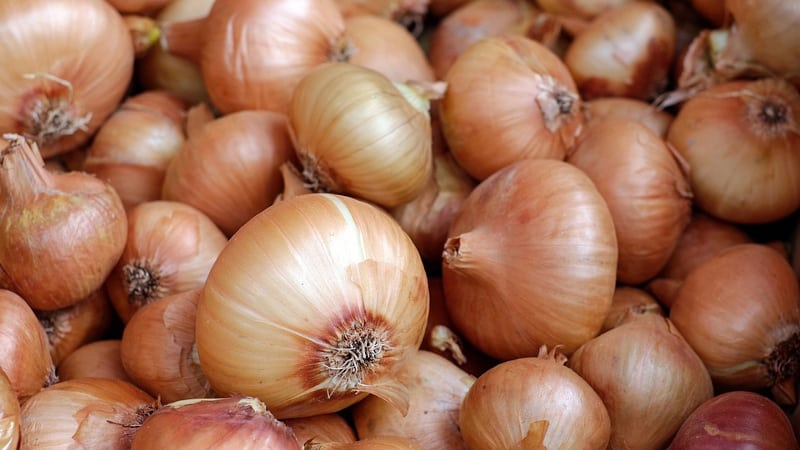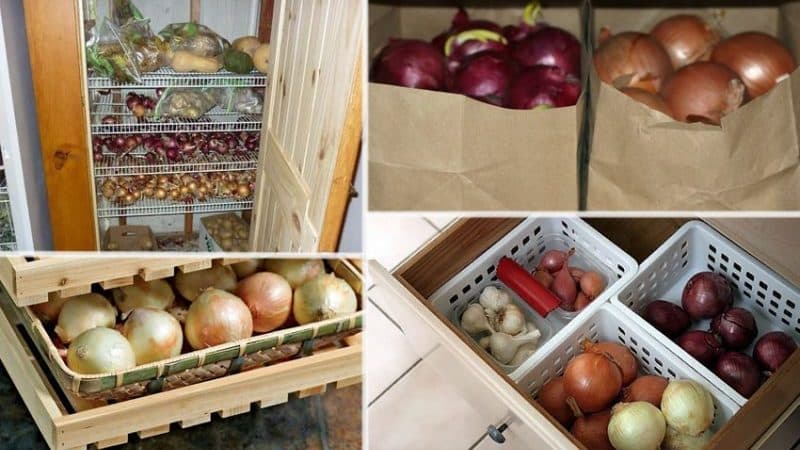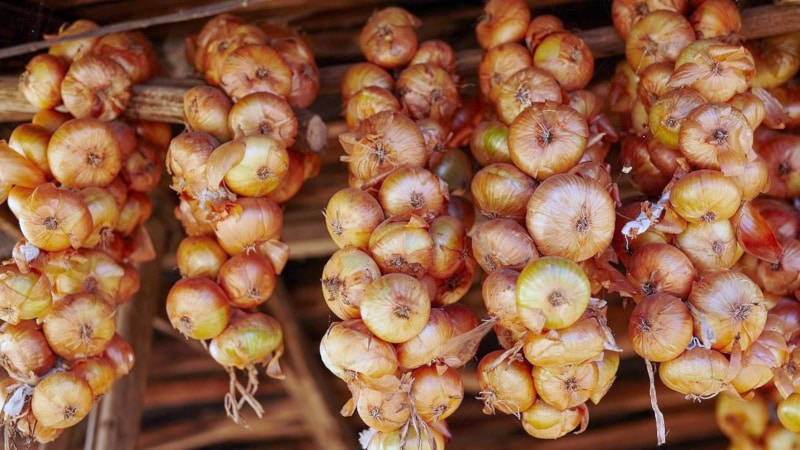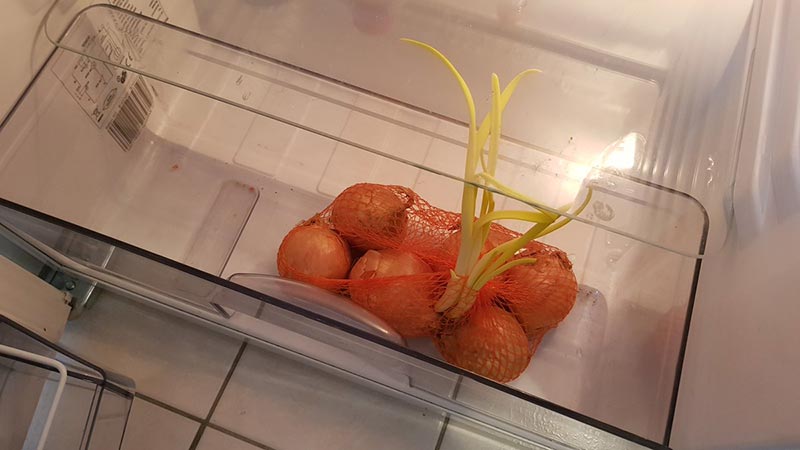Methods and terms of storing onions after harvesting
A rich onion harvest from your own plot is the dream of any gardener. This is a supply of tasty product for the whole winter, the most important ingredient in many dishes, as well as fresh vitamins and nutrients until the next season.
The article will tell you how to properly store onions and other varieties of onions at home.
Preparing onions for storage after harvest

Before onions are sent into storage for several months, they are selected and prepared. One of the most important conditions for good shelf life of a vegetable is timely harvesting from the garden. The bulbs fully ripen within 3-4 months from planting, but the timing varies depending on the variety and growing region. Fully mature turnips are maximally saturated with juice and filled with a whole range of vitamins and nutrients.
Work in the garden is carried out in dry weather, preferably on a warm and sunny day. Such vegetables are minimally at risk of rotting. It’s easy to determine that it’s time to collect by looking at the feathers that have dropped to the ground and dried out. When pulling turnips from the soil, try not to damage the root part and dry feathers. Vegetables are shaken off from remaining sand and soil, without hitting them too hard on hard surfaces to avoid damage to the heads.
After harvesting, the next stage begins - drying the crop. Any convenient method is suitable:
- laying out turnips on wooden floors or on a blanket in a summer cottage (in stable, dry and warm weather);
- drying onions on the veranda under a canopy or on an open balcony;
- hanging in small bunches of 5-7 heads (to prevent contact with any surfaces).
Drying time is 10-12 days. The readiness of turnips for storage is determined by the peel: it becomes smooth, slightly shiny, and the scales are easily separated.
Reference. If there is no summer cottage or balcony in the apartment, onions are dried using an oven. The vegetable is laid out at a distance of 1-2 cm, set to the minimum temperature and left for 1-2 hours.
Before the harvest is sent for storage, it is sorted and rejected. Spoiled, rotten and damaged turnips are put aside and used first. They keep in the refrigerator for 2-3 weeks.
Optimal conditions for preservation
To preserve onions throughout the winter, maintain a temperature range from -3 to + 2°C. In such conditions it does not germinate or rot. The optimal humidity level is 70-80%.
Many housewives store bulbs in the apartment. Temperatures from +18 to +20°C are allowed, but under such conditions the product deteriorates and rots much faster. In warm conditions, turnips actively germinate already in 4-5 weeks, so it will not be possible to save them until spring.
Attention. To reduce high humidity, containers with ash, sawdust or lime are placed in storage facilities. These substances will protect the heads from rotting and absorption of excess moisture.
It is recommended to ventilate the room regularly, providing the vegetables with sufficient air ventilation.
What can you store onions next to?
The best neighbors for onions are garlic, and the worst are beets and potatoes. Many gardeners place turnips along with root crops in the cellar in one mound.In this case, the shelf life of potatoes is reduced, as excess moisture is released from the bulb.
It is allowed to be adjacent to radishes and white cabbage, but it is not recommended to be with bell peppers, carrots, Chinese cabbage, and fruits.
Storage areas for onions
Depending on their capabilities, gardeners choose the most affordable and most convenient way to plant vegetables for the winter.

In the cellar/basement
Before shipping vegetables, the room is prepared, thoroughly ventilated, and, if necessary, disinfected. Remove all remnants of spoiled food and last year's supplies. The optimal air temperature is -1...+2°C, humidity is from 75 to 78%. Under such conditions, the onions remain until spring, and mold and rot do not appear on the heads.
It is recommended to regularly inspect the bulbs, and if damage, rot or other diseases are detected, the identified specimen is removed from the general storage.
At home
Vegetables are stored in the apartment under the so-called thermal regime. It is important to maintain a constant air temperature - from +18 to 20°C (maximum permissible +24°C, but onions germinate quickly).
In apartments they use cardboard boxes or plastic containers with holes for air to enter. Ventilation prevents rotting and spoilage of the product. A suitable place is a pantry where there are no heating devices.
If there is a balcony, turnips are stored in wooden boxes and, if necessary, insulated with blankets.
Important. If during severe frosts the container with supplies is moved into the apartment, the onions will begin to germinate quickly, but most of the heads deteriorate due to the sharp temperature change.
In the vegetable store
Vegetable storage facilities are special prepared premises where onions are stored in industrial quantities.From there, it goes on sale to markets all winter, maintaining its presentation, taste and beneficial properties.
The premises are equipped with modern devices that control humidity, temperature and lighting. All warehouses are equipped with automatic ventilation systems. Automation is designed to ensure minimal crop losses.
Large containers with a capacity of 35 to 45 kg are used in warehouses, and onions are also stored in huge mounds.
Storage methods

Over the years, housewives have been learning from each other the experience of storing onions and choosing simple, accessible devices and means for this task:
- braids – dried turnips are woven into braids using strands, carefully tying them to the dry tips of the feathers;
- wooden and cardboard boxes – several holes must be made in them on all sides for air access (a convenient way to store large volumes of crops on balconies, in storerooms, in cellars);
- in grids – convenient containers that allow you to regularly inspect the stock and detect damaged items; polyethylene mesh packaging is suitable for short-term storage – 1-2 months;
- nylon stockings – convenient to use in pantries or cellars, they hold about 10-15 kg of onions and allow air to pass through well, allowing vegetables to “breathe”, in addition, the product is better stored in a suspended state;
- packages – turnips in dense plastic packaging do not last long due to the lack of constant access to air and accumulating condensate.
Reference. To preserve the quality of the bulbs, they are sprinkled with dry husks in any container, which helps prevent drying out.
Secrets of storing onions
There are several tricks and secrets to keep the product fresh for a long time. For example, roots that were cut incorrectly when digging up the crop germinate after a short period of time. To prevent this from happening, they are carefully set on fire.
Another way to prevent sprouting is to coat the tips of the turnips with lime paste. This will stop the green feathers from appearing and the heads from spoiling.
Processing the root parts and tips of turnips makes them unsuitable for subsequent planting. Therefore, this method is not used for sowing.

Storing leeks
Leek stems are best preserved in the refrigerator in compartments specially designated for vegetables. The duration of such maturation is 2-3 weeks, it can be extended, freezing product. Before sending to the freezer, the onions are wrapped in cling film or chopped and sent to the freezer. It is recommended to cut off most of the green stem and the root part.
At temperatures above 0°C on the balcony, the vegetable remains fresh if you insert its stems into a box with sand.
Reference. Leek It withstands frost well and does not lose its taste and beneficial properties when stored on the balcony from -5 to -8°C. At the same time, he is placed in boxes and wrapped in a warm blanket.
Green onions
It is difficult to keep greens fresh for a long period, so the feathers are finely chopped and sent to the freezer. In this form, the product is ready for use in hot dishes or salads in winter.
Onion sets
The onion set harvest is completed by the end of August. First, the turnips are well dried, spoiled or soft specimens are selected. Drying occurs at a temperature of 30-35°C, this will protect the seed from rotting and will allow you to save it until the start of the season.
The optimal storage method is in linen or canvas bags at a temperature of no more than +17°C. The stock is sorted 2 times a month to remove rotten specimens and prevent the spread of diseases to the entire stock. The refrigerator is also a good place, as long as it stays within 1-2°C of heat.
Selected for storage onion sets more than 1 cm in diameter, and small bulbs are left in the soil. In early spring, most of them will produce young shoots.
Shelf life
The duration of storage is determined not only by the optimal temperature and humidity, but also depends on the variety. Under optimal conditions, the product lasts for 5-6 months without signs of spoilage. Yalta onions will last up to 4 months. When peeled, fresh turnips last no more than 5-6 days on the refrigerator shelves and 6 months in the freezer.
Green onions and leeks stay fresh in the refrigerator for up to 2 weeks, so they are preferred to be frozen chopped. The product will last in the cellar for up to 2 months.
Mistakes to Avoid
Violation of the rules for preparing and placing turnips for winter storage leads to inevitable damage to the entire harvest. Experienced gardeners recommend paying attention to possible causes of rotting bulbs and other problems.
Possible problems
Some of the most common problems encountered include product rotting and feather sprouting. Sprouted specimens are not recommended for consumption; they are planted in containers with soil or water on windowsills for further growing of greenery. The heads themselves lose their elasticity, become sluggish and rotten.
Causes of rotting
The main reasons for the rotting of onions stored for the winter are inattention to the harvest:
- violation of harvesting deadlines and technology (working in the garden in rainy weather or after severe frosts);
- non-compliance with drying technology (insufficient duration or placement of collected turnips in conditions of high humidity);
- unsuitable room (with high humidity, lack of ventilation, bright lighting).
In addition, turnips are sometimes affected by typical diseases - neck rot (outwardly manifested by a grayish coating and progressing very quickly, spreading to the entire stock) or root rot (the fungus appears as a white coating on the root part, and inside the fruit becomes watery and lethargic).
Reference. If a characteristic putrid odor appears in the room, this indicates the appearance of a diseased bulb, which attracts insects - bulb flies. It is recommended to immediately remove the damaged copy.
Results
Winter storage of onions requires strict adherence to temperature and humidity conditions. When maintaining optimal parameters, proper preliminary preparation and drying of the harvested crop, it is stored until the onset of the new sowing season.
This unpretentious vegetable fits well on balconies and cellars, in the refrigerator and freezer, and in the cold season it pleases with its fresh aroma and is used daily in cooking.